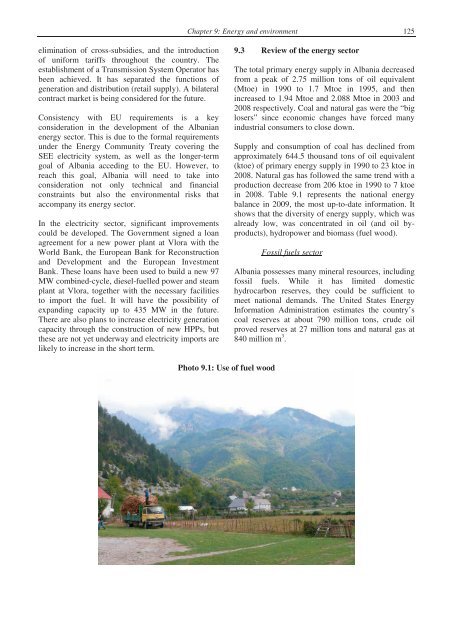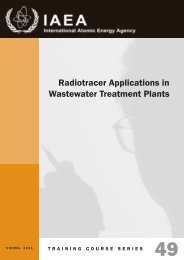Second Environmental Performance Review of Albania
Second Environmental Performance Review of Albania
Second Environmental Performance Review of Albania
Create successful ePaper yourself
Turn your PDF publications into a flip-book with our unique Google optimized e-Paper software.
Chapter 9: Energy and environment125elimination <strong>of</strong> cross-subsidies, and the introduction<strong>of</strong> uniform tariffs throughout the country. Theestablishment <strong>of</strong> a Transmission System Operator hasbeen achieved. It has separated the functions <strong>of</strong>generation and distribution (retail supply). A bilateralcontract market is being considered for the future.Consistency with EU requirements is a keyconsideration in the development <strong>of</strong> the <strong>Albania</strong>nenergy sector. This is due to the formal requirementsunder the Energy Community Treaty covering theSEE electricity system, as well as the longer-termgoal <strong>of</strong> <strong>Albania</strong> acceding to the EU. However, toreach this goal, <strong>Albania</strong> will need to take intoconsideration not only technical and financialconstraints but also the environmental risks thataccompany its energy sector.In the electricity sector, significant improvementscould be developed. The Government signed a loanagreement for a new power plant at Vlora with theWorld Bank, the European Bank for Reconstructionand Development and the European InvestmentBank. These loans have been used to build a new 97MW combined-cycle, diesel-fuelled power and steamplant at Vlora, together with the necessary facilitiesto import the fuel. It will have the possibility <strong>of</strong>expanding capacity up to 435 MW in the future.There are also plans to increase electricity generationcapacity through the construction <strong>of</strong> new HPPs, butthese are not yet underway and electricity imports arelikely to increase in the short term.9.3 <strong>Review</strong> <strong>of</strong> the energy sectorThe total primary energy supply in <strong>Albania</strong> decreasedfrom a peak <strong>of</strong> 2.75 million tons <strong>of</strong> oil equivalent(Mtoe) in 1990 to 1.7 Mtoe in 1995, and thenincreased to 1.94 Mtoe and 2.088 Mtoe in 2003 and2008 respectively. Coal and natural gas were the “biglosers” since economic changes have forced manyindustrial consumers to close down.Supply and consumption <strong>of</strong> coal has declined fromapproximately 644.5 thousand tons <strong>of</strong> oil equivalent(ktoe) <strong>of</strong> primary energy supply in 1990 to 23 ktoe in2008. Natural gas has followed the same trend with aproduction decrease from 206 ktoe in 1990 to 7 ktoein 2008. Table 9.1 represents the national energybalance in 2009, the most up-to-date information. Itshows that the diversity <strong>of</strong> energy supply, which wasalready low, was concentrated in oil (and oil byproducts),hydropower and biomass (fuel wood).Fossil fuels sector<strong>Albania</strong> possesses many mineral resources, includingfossil fuels. While it has limited domestichydrocarbon reserves, they could be sufficient tomeet national demands. The United States EnergyInformation Administration estimates the country’scoal reserves at about 790 million tons, crude oilproved reserves at 27 million tons and natural gas at840 million m 3 .Photo 9.1: Use <strong>of</strong> fuel wood
















